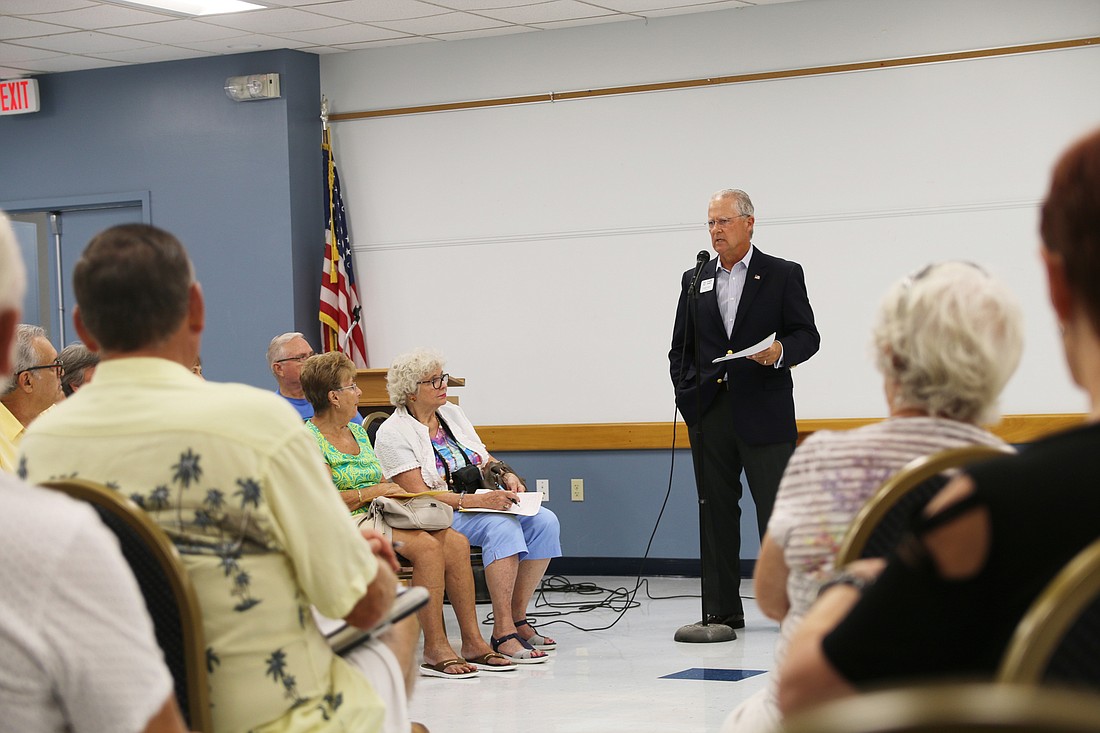- December 13, 2025

With the city moving ahead in designing the first phase of a septic to sewer conversion in the north peninsula — and a small area inside the city — the biggest question continues to linger on residents' minds: How much is it going to cost?
It's an answer that City Commissioner Dwight Selby, who is spearheading the effort in Ormond Beach, is yet to be able to provide, since the designing process, as well as the subsequent proposal estimates from contractors, have not been completed. However, there are five knowns Selby was able to provide to the estimated 75 people who attended the Civil Discourse town hall on the topic on Monday, July 22.
The city won't know the total cost for homeowners until an engineer is hired to design the system, and Selby said the hiring process alone could take 3-6 months. Then, it would take an additional 6 months to design, and after that, homeowners will be presented with a cost. It's likely the city will offer three different contractors for people to choose from, he later added.
Selby said that he understood the septic to sewer endeavor is "incredibly intrusive," but maintained that it has nothing to do with annexation and the rezoning of 1,900 homes in the north peninsula by Volusia County.
“There is no connection between any of those three topics," Selby said. "Period.”
Selby believes it is the city's responsibility to provide sewer to the north peninsula, since that area are already city water customers and Ormond Beach has the sewer plant capacity for all the residences. Like water, sewer customers would have to pay a higher base rate for service than those who live within the city limits of Ormond Beach. The monthly base rate is currently $28.94.
The good news, Selby said, is that because the north peninsula is a high-density area, retrofitting it to sewer will be more cost effective. Less pipes would need to be run, as the houses are closer together.
Ormond Beach is working to secure funding partners for the project, which is divided into 10 phases with the first being 700 homes from Plaza Drive to Longwood Drive. Some of the possible funding sources include the St. John's River Water Management District, Volusia County, the Florida Department of Environmental Protection, state funding and the use of Community Development Block Grants.
Selby also pointed out that Rep. Paul Renner, whose current district includes Ormond-by-the-Sea, is likely to become the Speaker of
the Florida House in 2022.
“Right now, leadership controls where the money goes," Selby said.
Ormond Beach resident Ken Sipes, who was one of the founders of CANDO 2 last year, said water quality is going to be an important issue going into the future, and that we can't shy away from it.
“This topic — septic to sewer and trying to clean our water — is another huge challenge for us to take on and we’re going to need a team effort to solve it," Sipes said.
One resident asked if the city would repair the roads, driveways and damage to lawns that could occur as part of the project. Selby said yes. When asked if he knew the extent of the possible impact, Selby said it's too early to tell yet. But whatever happens, the construction process won't be pleasant.
“Honestly, it’s going to be awful," Selby said. "When we’re doing your street, you’re going to wish you were living somewhere else. I’m not going to try to sugarcoat it, because it’s going to be a mess, and it’s going to be probably for a couple of months or maybe longer.”
Ormond Beach resident Peggy Farmer said that, as a former nurse, she was interested in the 2013 report by the Florida Department of Health in Volusia County, which deemed the north peninsula as unsuitable for septic. It's taken six years for the conversation to get to this point, and Farmer said the discourse was healthy.
"I really think if we can focus on the facts and come together, because Ormond Beach and Ormond-by-the-Sea — we’re friends and we’re neighbors, and we have to solve this," Farmer said.
Ormond-by-the-Sea resident Melissa Lammers, who is also a past president of the Halifax River Audobon and co-administers the North Peninsula Preservation Facebook group, said the septic issue has plagued the area since she was a little girl. Having clean water for future generations matters to the community, she said, and while there is no "perfect way" to treat it yet, she believes this is a real opportunity to move to sewer.
“We are all polluting in one way or another," Lammers said. "We can stop putting fertilizer on our lawns but really can’t stop producing our own waste.”
However, she wondered if the city would be able to offer quantifiable metrics that the water will, in fact, be cleaner by going to septic.
City Public Works Director Gabe Menendez said the city has an advanced plant that removes the nutrients (nitrogen and phosphorous, which can cause algae blooms and the death of fish), and that this is the best solution since the river flushes both north and south.
“It will improve it more than it is today because we’re taking what is being dumped in there and we’re taking the nutrients out of the system," Menendez said. "How much it will improve it? I can’t tell you.”
Selby said there is very little tidal flow in the Halifax River.
“It’s a long-range strategy to get this better," he said. "We have to stop introducing the nutrients, and then overtime, it will be reduced.”
This story was updated at 2:37 p.m. on Wednesday, July 24, to reflect that Melissa Lammers is the past president of the Halifax River Audobon. A previous version of this story stated she was the organization's current president.